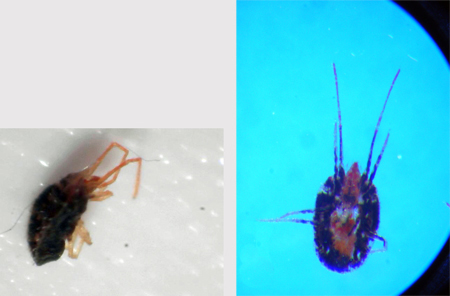Clover mites are swarming in the Upper Peninsula
Editor’s note: This article is from the archives of the MSU Crop Advisory Team Alerts. Check the label of any pesticide referenced to ensure your use is included.
Mike Erdman sent in some very nice photos of clover mites that a client had brought into the Menominee County Extension office. Clover mites, Bryobia praetiosa (Acarina: Tetranychidae) are among the smallest home invaders we have in Michigan. They belong to the spider mite family Tetranychidae and, as the name implies, they feed on clovers and grasses. People often mistake clover mites for minute, six-legged insects because their front legs are considerably longer than the others and they are projected forward giving them the appearance of antennae (mites do not have antennae). Lush growing, well-fertilized lawns tend to produce the largest number of clover mites. For whatever reason, newly established lawns also seem to produce large numbers of clover mites. When conditions are right, clover mites can invade homes by the thousands. This normally happens in the spring, but fall invasions also occur. They are small enough to crawl right through window screens and through cracks around windows, doors and other external openings. If they are crushed during attempts to wipe them up, they leave tiny red stains.
Clover mites are usually a temporary nuisance. They appear suddenly and are generally gone a few days later. Household aerosol insecticides can be used to kill the mites indoors, if deemed necessary, but a soapy rag or wet sponge work just as well on indoor surfaces. A vacuum cleaner equipped with a hose and a soft brush attachment will also work. Wipe or brush carefully to avoid crushing the mites and causing stains. Mites can be removed from the outside of buildings with a garden hose. An insecticidal soap can be concocted by using regular liquid dish-washing soap mixed at the rate of two tablespoons per gallon of water. These water-based treatments will not provide any residual control. A more aggressive approach would be a perimeter treatment of a persistent insecticide along the outside walls and extending about 10 feet out from the foundation. Be sure to read and follow all instructions and safety precautions found on the label before using any pesticide.
The best long-term method for reducing persistent clover mite invasions is by providing a grass-free band, 18-24 inches wide, around the house. This can easily be accomplished by open areas of course sand or pea stone, or by installing a plant bed. Removing clovers and other groundcovers from the lawn may also help prevent mite numbers from building up in lawns.



 Print
Print Email
Email




